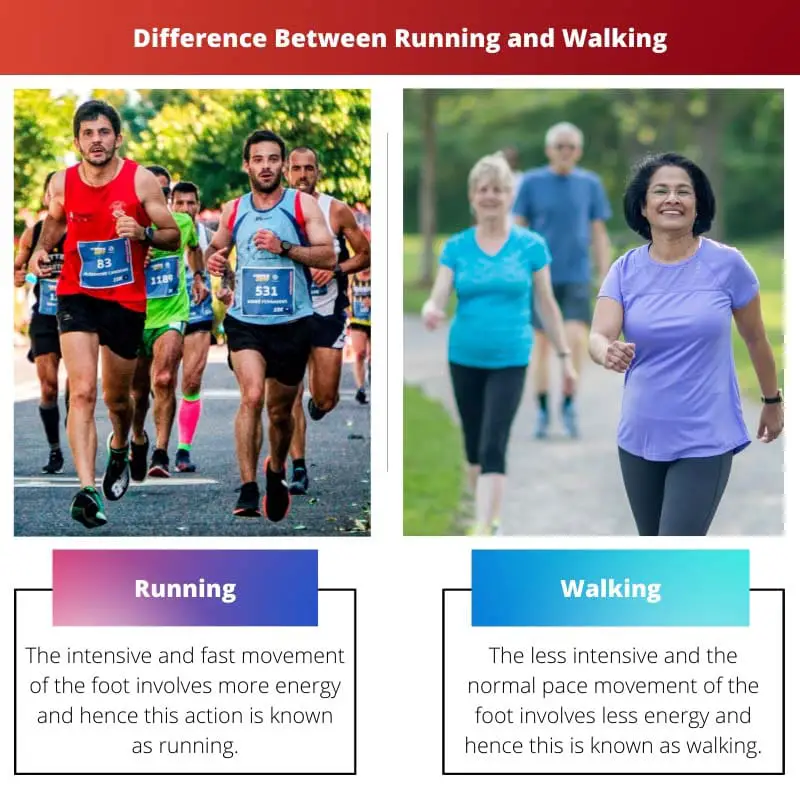Being active makes a person feel more physically and mentally energetic. Physical activities should always be a part of everyone’s daily life as it makes you feel refreshed. And, Running and Walking are two such physical activities that are widely practised amongst many people. Both running and walking help a person get into the perfect shape and size, and it depends upon an individual whether to choose running or walking accordingly. There are several differences between them.
Key Takeaways
- Running involves a continuous gait with both feet off the ground at some point while walking has one foot on the ground at all times.
- Running burns more calories and provides a more intense cardiovascular workout than walking.
- Walking has a lower risk of injury, making it suitable for beginners and those with certain health conditions.
Running vs Walking
Walking is a low-impact exercise that can be done anywhere and anytime. Running is a higher-impact exercise that can help improve cardiovascular fitness, increase bone density, improve coordination and balance, and aid in weight management. Walking doesn’t exert more energy than running.

Running refers to the physical activity that involves the more intensive movement of the foot. Running is a more energetic cardio that requires a lot of strength and energy. Also, running takes less time to cover the same amount of distance than walking. It is least preferred for people with heart diseases as it can be termed more intensive workouts and can risk the person’s life sometimes.
On the other hand, walking refers to physical activity involving less intensive foot movement. Walking is comparatively less intensive and requires a bit of ease of strength and energy. Even though it requires energy, but not like intense movement like running. While walking, it takes more time to cover the same amount of distance than running. Also, it is more preferable to cardio exercise for people with diseases or problems as it maintains the problem and lowers the risk factors of the disease.
Comparison Table
| Parameters of Comparison | Running | Walking |
|---|---|---|
| Definition | The intensive and fast movement of the foot involves more energy and hence this action is known as running. | The less intensive and the normal pace movement of the foot involves less energy and hence this is known as walking. |
| Intensity | Running can be termed as a more intense workout. | Walking can be termed as a less intense workout. |
| Impact | Running can show more impact on the body in a lesser period as it involves heavy muscle movements that produce sweat from the body soon. | Walking can show less impact in a longer period as in walking the muscles are comparatively at ease and it takes time to produce sweat from the body. |
| Safety | Running is comparatively risky as it can sometimes affect the bones and muscles by losing bone or by tearing ligaments. | Walking is comparatively low at risk factors and sometimes it can only affect by some minor muscle cramps. |
| Preferable Cardio | Running is preferred only when someone wants to burn calories faster depending upon one’s choice and body type. | Walking is preferred only when someone wants to burn calories but can not perform heavy and cardio. It also depends upon an individual. |
| Doctor’s Preference | A doctor least prefers running over walking. | A doctor prefers walking the most as it can be performed by any age group. |
| Time | Running takes less time to complete the same given distance than walking. | Walking takes a bit longer time to complete the same distance than running. |
| Endurance | Running helps a person to maintain their endurance and therefore the person is capable of working for a longer period of. | Walking does not help to maintain the endurance for working. It only keeps the body physically active. |
What is Running?
In simple words, running is a physical activity that falls under the category of freehand cardio, which involves a person’s fast movements of their feet. Running involves the feet and the whole body muscles involved while running. It is also considered to be an intensive workout. This is because it requires more strength and energy to run. The professional runner practice and also requires other physical exercises as well to strengthen the muscles to run. They also have specific protein-rich diets.
Running can show more impact on the body in a lesser period as it involves heavy muscle movements that produce sweat from the body soon. Running can help the person get in shape and size quickly and is considered the best effective cardio for many people. When a person tends to run, they can cover the same distance in a lesser period, but the person must be physically active and strong. Running also helps a person to maintain their endurance, and therefore, the person is capable of working for a longer period of time. When a person is capable of running and maintaining it, the strength or energy of the person automatically increases, which helps the person in many cases in physical activities.
As we have talked about the advantages of running, there are also disadvantages. Sometimes running can cause some severe displacement of bones or muscles and even tear the ligaments of a person’s joints, which would further require surgery to fix.

What is Walking?
Walking is a widely practised physical exercise by any age group. It involves the slow pace of movement of the legs. Walking has been categorized into two types: morning walk and evening walk. It depends upon an individual’s convenience or the doctor’s advice on when to walk. Walking does not help to maintain endurance for heavy work. It only keeps the body physically active. And hence, it is easy and convenient for anyone to walk daily.
Walking can be termed as a less intense workout. While walking, a person is limited to a slow pace of speed, and therefore it can be termed intensive. Even though it is very effective for many patients or non-patient people, it slows its results slowly and gradually. Walking can show less impact over a longer period as the muscles are comparatively at ease, and it takes time to produce sweat from the body. As we know, sweat is the main key goal for any workout, therefore in walking, it takes a bit longer time to show up this kind of symptoms.
Walking is a low-risk factor, and sometimes it can only be affected by minor muscle cramps, and no severe side effects have been seen. Doctors also prefer walking over any physical activity as it is the easiest and steady workout that any age group can perform. Waling not only helps in losing weight, but it also helps in marinating sugar levels, cholesterol levels, Blood pressure levels, etc. Therefore, if one is not able to do any high intensive workout, one should try walking to stay fit and healthy.

Main Differences Between Running and Walking
- The intensive and fast movement of the foot involves more energy; hence, this action is known as running. On the other hand, the less intensive and normal pace movement of the foot involves less energy; hence, this is known as walking.
- Running can be termed as a more intense workout. On the other hand, Walking can be termed as a less intense workout.
- Running can show more impact on the body in a period span as it involves heavy muscle movements that produce sweat from the body soon. On the other hand, Walking can show less impact over a longer period as in walking, the muscles are comparatively at ease, and it takes time to produce sweat from the body.
- Running is comparatively risky as it can sometimes affect the bones and muscles by losing bone or by tearing ligaments. On the other hand, Walking is a comparatively low-risk factor, and sometimes it can only affect by some minor muscle cramps.
- Running is preferred only when someone wants to burn calories faster, depending upon one’s choice and body type. On the other hand, Walking is preferred only when someone wants to burn calories but can not perform heavy cardio. It also depends upon the individual.
- A doctor least prefers running over walking. On the other hand, a doctor prefers walking the most as any age group can perform it.
- Running takes less time to complete the same given distance than walking. On the other hand, Walking takes a bit longer time to complete the same distance than running.
- Running helps a person to maintain their endurance, and therefore the person can work for a longer period. On the other hand, Walking does not help to maintain endurance for working. It only keeps the body physically active.

- https://europepmc.org/article/med/1272008
- https://www.thelancet.com/journals/lancet/article/PIIS0140-6736(99)03179-7/fulltext

The differentiation between running and walking in terms of impact, safety, and doctor’s preference is particularly enlightening. It’s evident that individuals must consider their health conditions, endurance, and fitness goals when choosing between the two activities. This level of detail is commendable.
The separate descriptions of running and walking are very educational and leave no room for confusion. It’s clear that running is a more vigorous form of exercise requiring higher energy and strength, while walking is gentler but still beneficial for cardiovascular health. This is valuable information for those considering taking up either activity.
A very thorough comparison between running and walking. I appreciate the detailed breakdown of the benefits and drawbacks of each. It’s clear that both activities have their advantages and disadvantages, and it’s important for individuals to understand these differences when choosing which to incorporate into their fitness routine.
The table provided for the comparison of running and walking is a very effective way of illustrating the key differences between the two activities. It’s a well-organized and easy-to-understand visual aid that succinctly highlights the varying impacts, intensity, safety, and other factors of running and walking.
The explanation of running as a high-impact cardio exercise requiring significant strength and energy is informative. This makes a strong case for its effectiveness in calorie burning and endurance-building. The emphasis on the potential risks associated with running also serves as an important cautionary reminder.
The articulation of walking as a low-impact exercise suitable for various age groups and health conditions resonates well. The distinction between morning and evening walks is an interesting inclusion, as it underscores the flexibility and adaptability of this physical activity in daily routines.
The detailed descriptions of running and walking are highly insightful, providing a comprehensive understanding of both activities. The section outlining the nuances of running’s impact on the body and the advantages and disadvantages of walking is particularly enlightening and will undoubtedly inform readers’ choices.
The discussion of the pros and cons of running is extensive and well-presented. The emphasis on both the benefits of calorie burning and endurance maintenance, as well as the potential risks to bone and muscle health, offers a balanced and informative perspective on this high-impact exercise.